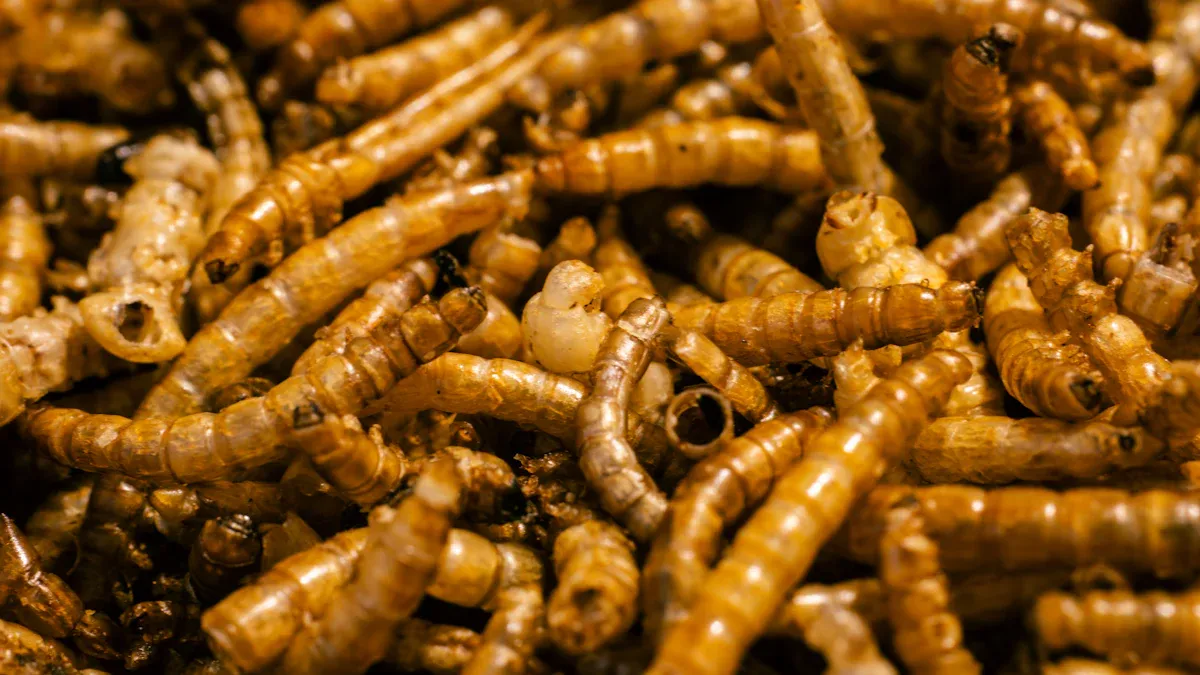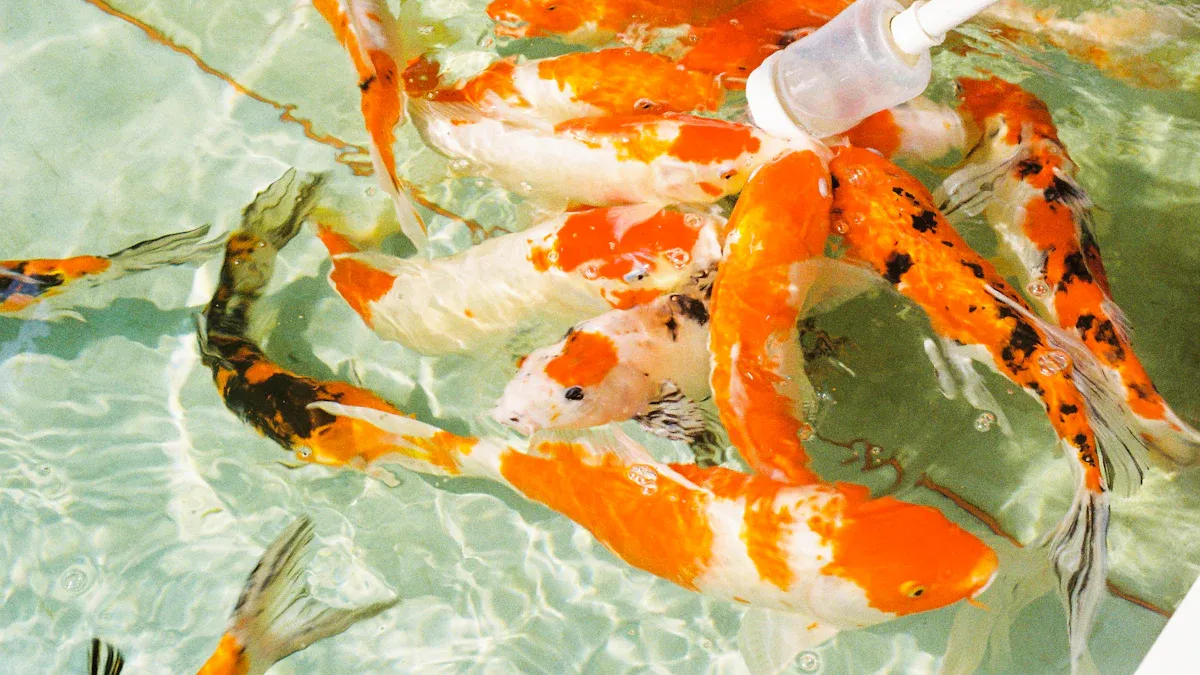
Feeding dried mealworms to fish transforms aquaculture. Packed with protein and essential nutrients, they help fish grow stronger and healthier. Studies show mealworms boost immune responses by activating genes like IgM and IgT, improving resilience. Their eco-friendly production also supports a sustainable future, making them a win-win for fish and the planet.
Key Takeaways
- Dried mealworms are packed with protein, offering up to 79%. This helps fish grow stronger and build muscles.
- Adding mealworms to fish food improves their health and immunity. They have chitin, which helps fight sickness and keeps fish healthy.
- Using mealworms means less need for overfished resources. It also cuts carbon emissions, making them a green choice for fish farming.
Nutritional Benefits of Feeding Dried Mealworms to Fish
High Protein Content for Enhanced Growth
Protein is the cornerstone of fish growth, and dried mealworms deliver it in abundance. With a protein content of up to 79%, they provide an excellent alternative to traditional fishmeal. This high protein level supports muscle development and overall growth in fish. For example, studies show that red hybrid tilapia fed with mealworm-based diets experienced significant growth improvements. Similarly, rainbow trout achieved better growth performance when 25% to 50% of their diet included mealworm meal.
The essential amino acid (EAA) profile of mealworms also meets the dietary needs of many fish species. These amino acids are vital for tissue repair, enzyme production, and metabolic functions. By incorporating dried mealworms into fish diets, farmers can ensure their fish receive the nutrients they need to thrive.
| Evidence Description | Fish Species | Result |
|---|---|---|
| High-protein mealworms (79%) used as an ingredient in tilapia feed formulation. | Red hybrid tilapia | Effective alternative protein source. |
| Essential amino acid profile meets dietary requirements of tilapia. | Red hybrid tilapia | Adequate EAA for growth. |
| Rainbow trout fed with 25% and 50% mealworm meal showed good growth performance. | Rainbow trout | Improved growth performance. |
Essential Fats and Amino Acids for Fish Health
Dried mealworms are not just about protein; they also contain essential fats and amino acids that promote fish health. These nutrients play a critical role in maintaining healthy skin, scales, and fins. Omega-6 fatty acids, found in mealworms, help regulate inflammation and support immune function.
A balanced diet with these essential fats ensures fish remain active and resilient. Amino acids, on the other hand, contribute to energy production and the synthesis of hormones and enzymes. When fish consume dried mealworms, they gain access to these vital nutrients, which enhance their overall well-being.
Boosting Immunity and Liver Health with Micronutrients
Feeding dried mealworms to fish does more than just improve growth—it also strengthens their immune systems and supports liver health. Mealworms contain chitin, a natural compound with immunostimulatory properties. Chitin enhances both cell-mediated and humoral immunity, making fish more resistant to diseases.
Antioxidant activity is another key benefit. Mealworm-based diets have been shown to elevate antioxidant enzyme levels, such as superoxide dismutase (SOD), while reducing harmful compounds like malondialdehyde (MDA). This improved antioxidant defense protects fish from oxidative stress and promotes liver health.
- Significant elevation in serum SOD and decline in plasma MDA levels in yellow catfish fed TM-based diets.
- Elevated antioxidant enzyme activities (SOD, CAT, GSH-Px) in the intestines of rainbow trout on TM diets, suggesting enhanced liver health.
- TM diets showed potential to augment immune responses and improve resistance against infectious pathogens.
| Evidence Type | Findings |
|---|---|
| Chitin Content | Immunostimulatory effects of chitin enhance both cell-mediated and humoral immunity in fish, improving resistance to pathogens. |
| Antioxidant Activity | TM supplementation led to elevated SOD and reduced MDA levels, indicating improved antioxidant defense in fish. |
| Protein Content | Contains antimicrobial peptides (AMPs) that increase fish resistance to bacterial pathogens such as A. hydrophila and E. tarda. |
By including dried mealworms in their diets, fish can enjoy better immunity, healthier livers, and greater resilience to environmental stressors.
Environmental Sustainability of Feeding Dried Mealworms to Fish
Reducing Reliance on Overfished Resources
Overfishing has put immense pressure on marine ecosystems. Many fish species are now at risk due to the high demand for fishmeal, a common ingredient in aquaculture feed. Feeding dried mealworms to fish offers a sustainable alternative. Mealworms provide a rich source of protein, reducing the need for fishmeal derived from overfished species.
- A study on rainbow trout fry showed that mealworm meal could replace traditional fishmeal without compromising growth or health.
- By using mealworms, fish farmers can lessen the demand for overfished species and help restore balance to marine ecosystems.
Switching to mealworm-based diets not only supports fish health but also protects ocean biodiversity. This small change can make a big difference in preserving aquatic life for future generations.
Lowering Carbon Emissions in Aquaculture
Aquaculture has a significant environmental footprint, but mealworms can help reduce it. Traditional fish farming often relies on feeds that contribute to greenhouse gas emissions. Mealworms, on the other hand, are a low-emission alternative.
Mealworm farming produces fewer greenhouse gases like carbon dioxide, methane, and nitrous oxide compared to livestock farming. Their production also generates less ammonia, which helps maintain air quality. By incorporating mealworms into fish diets, aquaculture operations can lower their carbon footprint and contribute to a cleaner environment.
Additionally, mealworms require less land and water to produce compared to traditional protein sources like beef or pork. This makes them an eco-friendly choice for sustainable fish farming.
Sustainable Mealworm Farming Practices
Mealworm farming is not only efficient but also environmentally friendly. Farmers use innovative practices to ensure sustainability and ecological balance. For example, mealworms have a water footprint similar to chicken meat but much lower than beef. They also require less energy and land to produce, making them a resource-efficient option.
- Optimal diets for mealworms improve their feed conversion efficiency, which is comparable to poultry.
- Probiotics and transgenerational immune priming are used in mealworm farming to prevent infections and maintain ecological balance.
These practices ensure that mealworm farming remains sustainable while meeting the growing demand for alternative protein sources. By adopting mealworms, fish farmers can support a greener future while maintaining high-quality fish production.
Practical Applications of Feeding Dried Mealworms to Fish

Integrating Mealworms into Fish Diets
Incorporating dried mealworms into fish diets is straightforward and effective. Farmers can replace up to 25% of traditional feed with mealworms without affecting fish growth. For shrimp farming, mealworms can completely replace fishmeal, leading to increased body weight and lipid content. Their nutrient profile closely resembles fish and soybean meal, making them a versatile option for aquaculture.
| Evidence Type | Details |
|---|---|
| Replacement Rate | Up to 25% of traditional feed can be replaced with mealworms. |
| Shrimp Farming | Complete replacement of fishmeal led to increased body weight. |
| Nutritional Profile | Similar to fish and soybean meal, suitable for various fish species. |
Farmers can mix mealworms with existing feed or use them as a standalone option. This flexibility makes feeding dried mealworms to fish a practical choice for aquaculture operations.
Compatibility with Various Aquaculture Systems
Dried mealworms work well across diverse aquaculture systems. Studies show they can replace up to 50% of fishmeal in rainbow trout diets, improving growth and protein utilization. They also enhance intestinal health, which is crucial for fish raised in intensive systems. Mealworms’ efficient growth rates and low resource needs make them a sustainable protein source.
- Mealworms improve protein utilization and intestinal histology in fish.
- They are compatible with systems requiring high-quality, sustainable feed.
- Rainbow trout fed mealworm-based diets showed significant growth benefits.
This compatibility ensures that mealworms can support fish health and growth in various farming setups, from small-scale ponds to large commercial operations.
Cost-Effectiveness and Long-Term Benefits for Fish Farmers
Using mealworms as fish feed offers economic and environmental advantages. Mealworms have feed conversion efficiency similar to poultry and higher nitrogen use efficiency than traditional livestock. This means they require fewer resources to produce while delivering comparable nutritional value. Over time, advancements in technology and market demand could make mealworms even more cost-effective.
Additionally, mealworm farming reduces waste and greenhouse gas emissions. These benefits align with the growing need for sustainable aquaculture practices. By adopting mealworms, fish farmers can lower costs, improve fish health, and contribute to a greener future.
Feeding dried mealworms to fish revolutionizes aquaculture. Their high nutritional value, efficient feed conversion, and eco-friendly production make them a standout choice. Studies show mealworms match poultry in nutrition and sustainability while boosting shrimp growth and digestibility. By adopting mealworms, farmers can achieve healthier fish, better growth, and a greener future.
| Benefit | Evidence |
|---|---|
| Nutritional Value | Mealworms provide similar nutritional values to poultry when reared optimally. |
| Feed Conversion Efficiency | Mealworms convert feed as efficiently as poultry, with higher nitrogen use efficiency than traditional livestock. |
| Environmental Sustainability | Mealworms can be reared more sustainably than livestock, reducing dependence on imported feed. |
| Growth Performance in Shrimp | Complete replacement of fish meal with mealworms increased body weight and lipid content in shrimp. |
| Improved Digestibility | Supplementation of weaning pig diets with mealworms improved growth performance and nutrient digestibility. |
Article by Felix.
FAQ
What makes dried mealworms a better choice than traditional fish feed?
Dried mealworms offer higher protein content, essential nutrients, and eco-friendly production. They support fish growth and health while reducing environmental impact. 🐟🌱
Can all fish species eat dried mealworms?
Yes, most fish species can consume dried mealworms. Their nutrient profile suits a wide range of fish, from tilapia to trout. 🐠
How should dried mealworms be stored?
Store dried mealworms in a cool, dry place. Use airtight containers to maintain freshness and prevent moisture. 🛑💧


